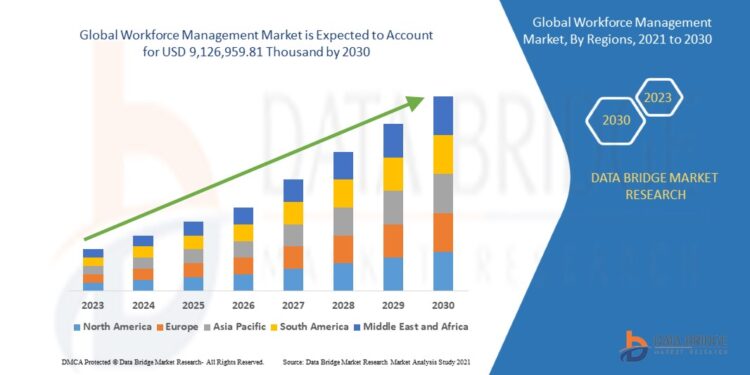What does Workforce Management mean?
Workforce management refers to the strategic planning, scheduling, and optimization of an organization’s workforce to effectively meet business objectives and operational needs. It involves various activities such as forecasting workforce demand, determining staffing requirements, scheduling shifts, managing time and attendance, tracking employee performance, and ensuring compliance with labor laws and regulations.
Workforce management maximises employee output by ensuring that all resources are available when they are needed. Forecasting, scheduling, skill management, intraday management, timekeeping, and attendance are common components of workforce management. Workforce management software frequently integrates with HR applications from outside businesses and important HR technologies that serve as important repository for employment data. This aids HR in effectively managing the workforce to raise productivity inside the company. Workforce management (WFM) sets up and controls personnel schedules to carry out a given work on a daily and hourly basis, efficiently satisfying the labour requirements. IoT and AI are introduced by workforce management to provide better human resource management solutions. Due to benefits including limitless scalability, control, and a wide range of options, the cloud sector is flourishing in the Asia-Pacific labour management market.
How does workforce management work?
Workforce management involves a systematic approach to planning, scheduling, and optimizing the workforce to meet business needs. Here’s an overview of how workforce management typically works:
- Demand Forecasting: The process begins with forecasting the demand for workforce resources. This involves analyzing historical data, market trends, seasonal patterns, and other relevant factors to estimate the workload and workforce requirements for a specific period.
- Workforce Planning: Based on the demand forecast, workforce planning takes place. It involves determining the number of employees needed, their skills and qualifications, and the desired staffing levels to meet the workload efficiently. This step may also include analyzing any skills gaps, succession planning, and developing strategies to address workforce requirements.
- Recruitment and Onboarding: Workforce management includes attracting, selecting, and hiring suitable candidates to fill open positions. This may involve advertising job vacancies, conducting interviews, background checks, and negotiating employment terms. Onboarding processes are implemented to integrate new hires into the organization effectively.
- Scheduling and Shift Management: Once the workforce is in place, scheduling and shift management come into play. This involves creating employee schedules that align with the forecasted demand and business requirements. Factors considered during scheduling include employee availability, skills, preferences, labor regulations, and workload distribution.
- Time and Attendance Management: Workforce management includes accurately tracking and managing employee time and attendance. This may involve using time tracking systems, biometric devices, or software to record employee work hours, breaks, leaves, and absences. Time and attendance data are crucial for payroll processing, compliance, and performance evaluation.
- Performance Management: Evaluating and managing employee performance is another aspect of workforce management. This includes setting performance goals, providing feedback, conducting performance appraisals, and identifying training and development opportunities. Performance management helps align individual and team performance with organizational goals.
To know more visit
https://www.databridgemarketresearch.com/reports/global-workforce-management-market
Enhancing Employee Productivity with Workforce Management Solutions
Enhancing employee productivity is a critical goal for organizations, and workforce management solutions play a significant role in achieving this objective. Here are some ways in which workforce management solutions can contribute to improving employee productivity:
- Efficient Scheduling: Workforce management solutions help create optimized schedules that align with workload demands, employee availability, and skills. By ensuring the right employees are scheduled for the right tasks at the right time, workforce management solutions prevent understaffing or overstaffing situations, reducing productivity bottlenecks and enhancing overall efficiency.
- Streamlined Time and Attendance Tracking: Workforce management solutions automate time and attendance tracking, eliminating the need for manual processes. This reduces administrative burden and minimizes errors. Accurate and reliable time tracking ensures that employees are paid correctly for their work, eliminates time theft, and promotes accountability, ultimately improving productivity.
- Self-Service Tools: Many workforce management solutions provide self-service features for employees, allowing them to view and manage their schedules, request time off, swap shifts, and update their availability. By empowering employees to have more control over their schedules and time management, these tools enhance job satisfaction, work-life balance, and engagement, leading to increased productivity.
- Task Prioritization and Visibility: Workforce management solutions often include task management features that allow supervisors and managers to assign and prioritize tasks efficiently. Employees can have clear visibility into their assigned tasks, deadlines, and priorities, enabling them to focus on high-value activities and complete tasks in a timely manner.
- Performance Monitoring and Feedback: Workforce management solutions often incorporate performance monitoring capabilities that track key performance indicators and provide real-time feedback. Managers can identify areas of improvement, provide timely coaching and support, and recognize and reward high-performing employees. Regular feedback and performance discussions contribute to employee development and motivation, boosting productivity.
- Training and Skill Development: Workforce management solutions can facilitate employee training and skill development initiatives. They can track employee certifications, skills, and training requirements, allowing organizations to identify skill gaps and provide targeted training programs. By improving employee competencies and knowledge, workforce management solutions enable employees to perform their tasks more effectively, leading to increased productivity.
Growth in Workforce Management Market
- According to Data Bridge Market Research’s analysis, the worldwide workforce management market is anticipated to grow at a CAGR of 10.2% from 2017 to 2030, reaching USD 9,126,959.81 million. The study on the global labour management market also includes pricing analysis, patent analysis, and technical improvements in great detail.
- Workforce management refers to the procedures and equipment that businesses utilise to raise employee effectiveness and productivity. The market for workforce management is expanding quickly due to the rising popularity of cloud-based solutions and the demand from companies to increase operational effectiveness. However, this market is also constrained by a number of factors, including a lack of skilled labour and the complexity of labour rules and regulations. In this environment, it’s critical to comprehend the market dynamics, trends, and difficulties that organisations encounter in the workforce management space.
About us
A pioneer in cutting-edge formative research is Data Bridge Market Research. We take satisfaction in providing data and analysis to both new and current customers that are appropriate for their objectives. The report may be altered to incorporate refurbished market and product base analysis, clinical trial outcomes data, literature research, and pricing trend analysis of target brands’ prices in new countries (ask for a list of countries). Technology-based analysis to market portfolio strategies may be used to analyse market analysis of target rivals. In the structure and data type you choose, we may include as many competitors as you need.































